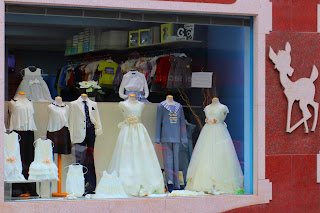Dancing in the streets

I saw something about the fiestas in Cañadas de Don Ciro this last weekend. Now Don Ciro really is no more than a wide spot on a very rural road but they have fiestas. It reminded me that I hadn't written anything about our own local fiesta which was a couple of weekends ago now. The Culebrón fiesta is one of a series for the outlying villages which are part the Pinoso municipality. The first village fiesta takes place in late Spring and they go on through the Summer with the villages taking it in turns to have a weekend of festivities. The fiestas are not usually particularly exciting or expansive but they are deeply ingrained in local culture and they offer the villagers a break from the routine with a chance to have a bit of a natter with friends, family and neighbours against the backdrop of some planned activities. There are usually two key themes. One is religious. Nearly all the fiestas are tied in to the patron saint for the village. The saintly effigies usually get an out...













